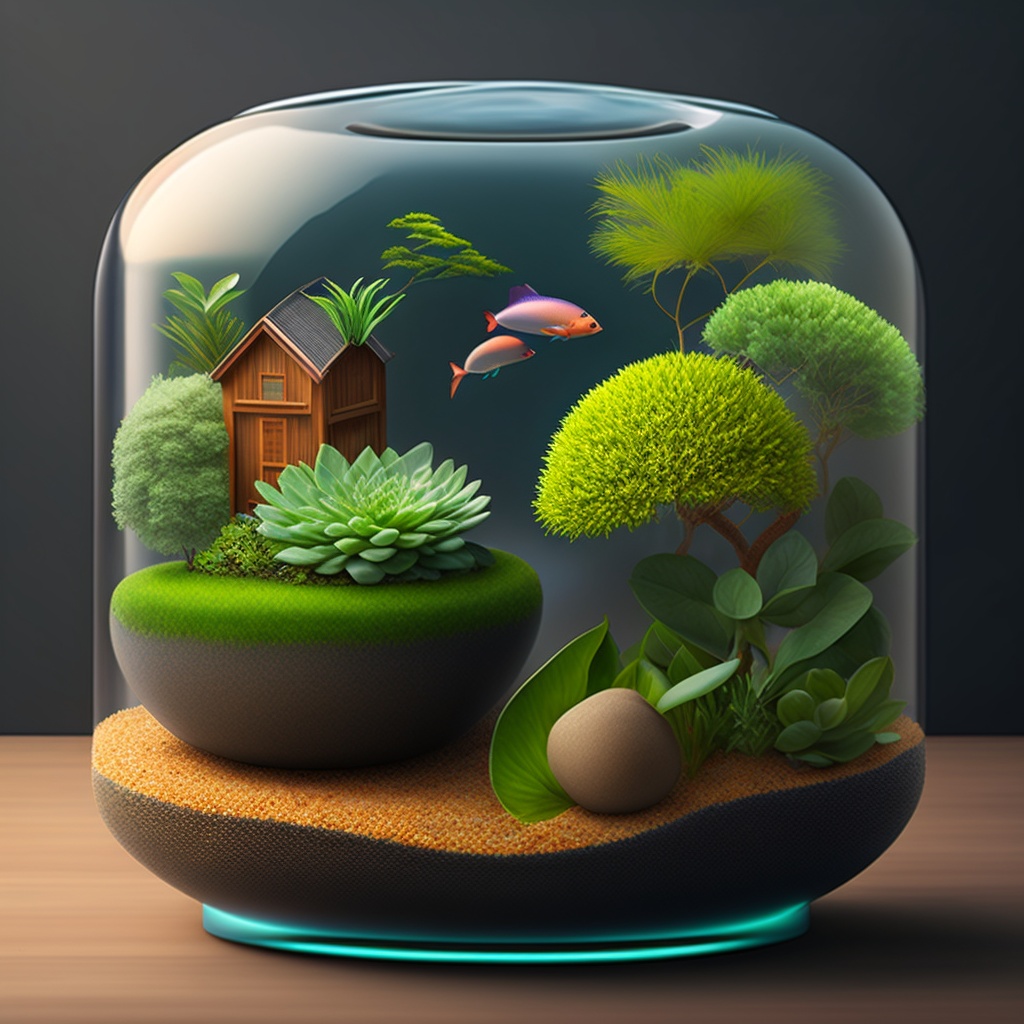Self Sustaining Ecosystem: Introduction
Life is full of complicated things, like assembling furniture or figuring out why cats insist on knocking things off tables. But some complexities are not only fascinating but downright magical. Enter the self sustaining ecosystem!
In essence, a self-sustaining ecosystem is a miniature world that requires little to no interference from humans. Think of it as nature’s autopilot mode. From a lush jungle to the deepest ocean trench, Mother Nature has perfected the art of self-maintenance. But what if you could replicate that same magic at home, in a fish tank or a glass jar?
Picture this: A tiny world thriving inside a transparent container where plants grow, creatures move, and life blossoms, all while you watch from the comfort of your couch. It’s like having a National Geographic documentary in your living room, except you get to choose the cast and script!
So, how does it all work? How do plants, animals, and microorganisms balance each other out, creating a harmonious miniature universe? Buckle up, dear reader, because we’re about to embark on a whimsical journey through the land of self-sustaining ecosystems. We’ll explore how they function, why they’re critical, and even how you can create one on your own. By the end, you’ll be a regular eco-system Einstein!
Why Is A Self-Sustaining Ecosystem Important?
You might be thinking, “This all sounds nifty, but why should I care about self-sustaining ecosystems?” Well, imagine never having to water your plants, feed your fish, or argue with a stubborn cactus about why it refuses to grow. That’s the beauty of a self-sustaining ecosystem, but it’s just the tip of the iceberg lettuce!
- Saves Time and Resources: If you’ve ever killed a houseplant by overwatering (or forgetting it existed), a self-sustaining ecosystem might be your new best friend. It takes care of itself, just like that one kid in every group project.
- A Living Lab: Science isn’t just for nerdy folks in white coats! A self-sustaining ecosystem lets you become a researcher in your living room. Observe the food chain, witness photosynthesis, and explore biodiversity without breaking out a textbook.
- Environmental Impact: You know that recycling bin you’ve been neglecting? A self-sustaining ecosystem is another step toward being environmentally friendly. It’s a microcosm of our planet, helping us understand how ecosystems function and teaching us valuable lessons about sustainability and conservation.
- Therapeutic Benefits: Ever stare into a fish tank and lose track of time? There’s a serenity in watching life unfold without human interference. It’s like meditation but with more algae.
- Educational Tool for Kids: Trying to pry your kids away from screens? Introduce them to a self-sustaining ecosystem, where they can learn valuable lessons about life, science, and responsibility. Plus, it’s way cooler than algebra.
- Aesthetically Pleasing: Imagine a verdant jungle or a serene pond inside a glass container, adding beauty and intrigue to your home or office. It’s a conversation starter and a living piece of art.
So, whether you’re an aspiring scientist, a busy parent, or just someone who loves to watch life unfold, self-sustaining ecosystems have something for everyone. They’re not just a novelty; they’re a peek into the beauty and complexity of life on Earth.
Now that we’ve set the stage, let’s dive into the nuts and bolts of how self-sustaining ecosystems actually work. Prepare to be amazed, perplexed, and possibly inspired to start naming snails. It’s going to be a wild ride!
How Does a Self-Sustaining Ecosystem Work?
Hold onto your hats, intrepid explorers, because we’re about to delve into the heart of the self-sustaining ecosystem. It’s like an all-you-can-eat buffet for nature lovers!
Components
First things first, let’s meet the all-star cast of this ecological drama:
- Plants: The producers of the show. They harness the power of sunlight through photosynthesis to create oxygen and food. They’re like the chefs of the ecosystem, whipping up a feast for the rest of the crew.
- Animals: These are the consumers, munching on plants, other animals, or both. They include everything from bugs to fish. Think of them as the dinner guests, enjoying what the green chefs have cooked up.
- Microorganisms: The unsung heroes. Microorganisms like bacteria break down waste and dead organisms, recycling nutrients back into the soil. They’re the cleanup crew after the big party.
- Water and Soil: The stage where it all takes place. Water and soil provide essential nutrients, while also helping to regulate the ecosystem’s temperature and acidity.
Energy Flow
The energy in a self-sustaining ecosystem flows like a perfectly choreographed dance:
- Sunlight: It all starts with the sun, beaming down like a spotlight on a stage. Plants grab this energy and use it to make glucose (sugar) and oxygen. It’s like photosynthesis is a solar-powered bakery!
- Consumers: The animals come along and munch on the plants, absorbing that energy and turning it into growth, movement, and a series of very cute yawns (if you have something like a hamster in there).
- Decomposers: When plants and animals die, microorganisms break them down, returning nutrients to the soil. Think of it as nature’s recycling program – no blue bins required!
- Recycling: The nutrients in the soil are then absorbed by the plants, and the cycle begins anew. It’s like nature’s never-ending merry-go-round.
Balance: The Secret Sauce
A self-sustaining ecosystem thrives on balance. It’s like a tightrope walker juggling flaming torches:
- Population Control: Too many plants and the animals overpopulate; too many animals and the plants get chomped down. It’s all about that sweet spot.
- Nutrient Cycling: The right balance of water, soil, and nutrients ensures that plants grow but don’t take over.
- Monitoring: Though the ecosystem is mostly self-sufficient, a watchful eye (that’s you!) can make adjustments if needed. Just like adding a dash of salt to a soup.
Real-Life Examples
A self-sustaining ecosystem isn’t just something you can create in a bottle or a fish tank. It’s a miraculous phenomenon that occurs all around the world, from the smallest patch of moss to the vast expanse of the ocean. Let’s take a tour of some real-life examples, and remember, no passports are required!
The Amazon Rainforest: Nature’s Pharmacy
The Amazon Rainforest is often referred to as the “Lungs of the Earth.” But beyond being a massive oxygen producer, it’s a dazzling example of a self-sustaining ecosystem.
- Complex Interdependence: Thousands of plant species, hundreds of mammals, and countless insects and microorganisms all coexist and depend on each other. Jaguars munch on capybaras, who in turn feast on aquatic plants. It’s a jungle out there, quite literally!
- Climate Regulation: The Amazon doesn’t just mind its own business; it affects the entire planet’s climate. Trees release water vapor, influencing rainfall patterns around the world. Forget cloud storage; this is cloud production!
- Challenges: Sadly, deforestation and climate change threaten this incredible ecosystem. Protecting the Amazon is like caring for a delicate, multi-layered cake that benefits us all.
The Great Barrier Reef: Underwater Wonderland
The Great Barrier Reef is more than just a hotspot for snorkeling enthusiasts. It’s a vibrant self-sustaining ecosystem that puts any aquarium to shame.
- Coral Polyps: These tiny creatures are the architects of the reef, building the complex structures that house a dazzling array of life, from colorful fish to menacing sharks.
- Symbiotic Relationships: Take the clownfish and sea anemones; they’re the BFFs of the marine world. Clownfish get protection, and anemones get cleaning services. Talk about a win-win!
- Threats: Like a beautiful painting fading over time, the Great Barrier Reef faces challenges such as coral bleaching and human activity. It’s a delicate masterpiece that needs our attention.
Yosemite National Park: Rocky Mountain High
Yosemite is not just a picture-perfect postcard; it’s a living, breathing self-sustaining ecosystem.
- Food Chain Magic: From tiny insects to towering bears, every creature plays a role. Plants provide nourishment for herbivores like deer, which in turn become prey for predators like mountain lions.
- Fire’s Role: Believe it or not, fire is an essential part of this ecosystem. Controlled burns help rejuvenate the soil and control underbrush. It’s like nature’s way of tidying up.
- Human Impact: The influx of tourists and climate change present challenges. Keeping Yosemite thriving is a balancing act that requires careful stewardship.
Microbial Mats: Earth’s Oldest Party
These are layered communities of microorganisms found in extreme environments like hot springs and salt flats.
- Ancient Wisdom: They’re among Earth’s oldest known ecosystems, dating back 3.5 billion years. Talk about a history lesson!
- Diverse Community: From bacteria to archaea, these mats are a bustling hub of microbial activity. It’s like a microscopic city with different neighborhoods and functions.
- Scientific Insights: Studying microbial mats helps scientists understand early life on Earth and even the potential for life on other planets. Who knew tiny bacteria could have such big implications?
These real-world examples showcase the wonder and complexity of self-sustaining ecosystems. From the grand scale of the Amazon to the microscopic intricacy of microbial mats, they’re a testament to nature’s ability to balance, adapt, and thrive. It’s like a never-ending symphony, with each part playing a crucial role in the harmony of life. Now, who’s ready to conduct?
Building a Self-Sustaining Ecosystem at Home: A DIY Guide
So, you’ve decided to take on the role of Mother Nature and build your very own self-sustaining ecosystem at home? Bravo! Whether you’re looking to recreate the Amazon in an aquarium or make a desktop version of the Great Barrier Reef, here’s your step-by-step guide to becoming a miniature ecosystem maestro.
- Choose Your Container: Home Sweet Home
The first step is picking the right container. You could go for a traditional aquarium or something unique like a mason jar or terrarium. Think of it as choosing a plot of land for your mini-world.
- Size Matters: The bigger the container, the more complex your ecosystem can be. However, smaller containers are easier to manage and maintain. It’s like deciding between a mansion and a cozy cottage.
- Material: Opt for something clear, like glass or transparent plastic, to easily observe your ecosystem. It’s like having a window into another world.
- Add Substrate: The Foundation
The substrate is the soil or gravel that serves as the base.
- Soil: For a plant-heavy ecosystem, nutrient-rich soil is key. It’s the equivalent of laying down plush carpeting for your plants.
- Gravel: In an aquatic environment, gravel works well, allowing water to flow. It’s like the hardwood floors of the underwater world.
- Plant Life: Greening Your Scene
Choosing the right plants is like casting the stars of your show.
- Aquatic Plants: For water-based ecosystems, opt for plants like Java Moss or Elodea. They’re like the water lilies of the home ecosystem world.
- Terrestrial Plants: For a land-based ecosystem, small ferns or succulents might be the way to go. They’re the easygoing roommates of the plant world.
- Add Water and Microorganisms: Bringing Life
Water quality is crucial, and adding microorganisms helps in breaking down waste.
- Water Source: Tap water might contain chlorine, so using filtered or distilled water is wise. It’s like providing a purified drink for your ecosystem’s inhabitants.
- Microorganisms: Consider adding a scoop of pond water or garden soil to introduce beneficial bacteria. They’re the tiny custodians that keep things clean.
- Animal Inhabitants: Casting Call
If you want to introduce small creatures, make sure they’re suitable for your chosen environment.
- Aquatic Options: Shrimps or snails are great for water-based ecosystems. They’re like the underwater pets you never knew you needed.
- Land Lovers: Consider insects like ladybugs or worms for terrestrial ecosystems. They’re nature’s little landscapers.
- Light and Temperature: Setting the Mood
Proper lighting and temperature are essential.
- Sunlight: Natural light can be used, but be cautious of overheating. Artificial lights designed for plants can work wonders.
- Temperature: Keep the ecosystem at a stable temperature. Too hot or cold, and you’ll have some unhappy residents.
- Monitor and Adjust: Play the Role of Nature
Keep an eye on your ecosystem, and make minor adjustments as needed.
- Observation: Check on your ecosystem regularly, but resist the urge to intervene too much. Let nature do its thing!
- Adjustments: If something seems off, make small changes. It’s like tuning a guitar to get the perfect sound.
Congratulations, you’ve created a self-sustaining ecosystem at home! Now, sit back and watch life unfold, just as nature intended. You’ve become a director, producer, and audience member in the greatest show on Earth (or at least in your living room).
Building a self-sustaining ecosystem at home is not just a fun project; it’s a fascinating look into how life operates. Whether it’s a desktop terrarium or a grand aquatic scene, your miniature world will provide endless joy, learning, and a sense of connection to the intricate dance of nature. Just don’t forget to send invites to the grand opening.
Conclusion: Embracing the Future with Self-Sustaining Ecosystems
As you take your final look into your self-sustaining jar of wonders, it’s hard not to be captivated by its metaphorical richness. This tiny world in a jar reflects much larger truths about life, balance, and the interconnectedness of all living things. It serves as a microcosm, an intimate study of Mother Nature’s ways.
In fact, a self-sustaining ecosystem is an intricate balance of life forces, each element relying on the other, much like our planet. So, as you embark on this enriching journey, consider it as not just a hobby but also a learning experience. This is more than just an artful centerpiece or conversation starter; it’s a small-scale model of the universe at work. Now, with your newfound knowledge and appreciation, go create your own magical world. May your ecosystem be as self-sufficient as a teenager with a smartphone!
Self Sustaining Ecosystem FAQs
-
Can I use any container?
While it may be tempting to go for the most aesthetically pleasing container, it’s important that the container is clear and transparent. This isn’t just for aesthetic reasons but for practical ones. A clear container allows you to observe the inner workings of your ecosystem, which is crucial for understanding its health and balance. You’ll want to see the magic happen—whether it’s plant growth, animal activity, or simply the captivating interplay between all the elements of your miniature world.
What if something goes wrong?
First, don’t panic. The beauty of a self-sustaining ecosystem is that it’s designed to balance itself. However, if you notice something significantly off—perhaps the plants are wilting or the water looks cloudy—it’s time for some troubleshooting. Adjusting the levels of sunlight or water might be the first step. If the issue persists, it might be beneficial to consult with a friend who has a strong understanding of biology or ecosystems. After all, a quick consultation can often provide you with the insights you need to get things back on track.
How long does it take to set up?
Setting up your self-sustaining ecosystem is relatively straightforward, but the time it takes can vary based on the complexity of the ecosystem you’re aiming for. For a basic setup with a few plants and perhaps a small aquatic creature like a snail, you can expect to spend an afternoon getting everything in place. The time you invest in setting up is minor compared to the long-lasting joy and education it provides. In essence, it takes an afternoon to set up, but it offers a lifetime of learning and enjoyment.
Can it really survive without intervention?
For the most part, yes! A well-designed self-sustaining ecosystem should require minimal intervention. However, this doesn’t mean you should completely ignore it. A loving glance now and then won’t hurt and, in fact, keeping an occasional eye on your ecosystem will help you notice if anything starts going awry. While these ecosystems are designed to be self-sufficient, they are not completely devoid of vulnerability. Occasional monitoring can go a long way in ensuring its longevity.
Why am I suddenly interested in snails?
Ah, the allure of the self-sustaining ecosystem! It has a way of turning even the least nature-inclined among us into enthusiastic ecologists. The joy of watching a snail slowly move through its habitat, interacting in a tiny but profound way with its environment, can be captivating. Snails, like all elements in your ecosystem, play an important role in maintaining balance. They help decompose plant matter, aerate the soil, and even act as a food source for other creatures. So, your newfound interest in snails isn’t just a whim; it’s a testament to the captivating power and educational value of creating your own self-sustaining ecosystem. Welcome to the club!




